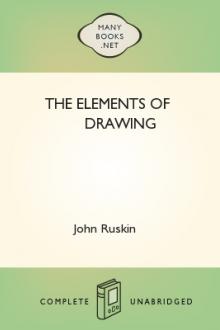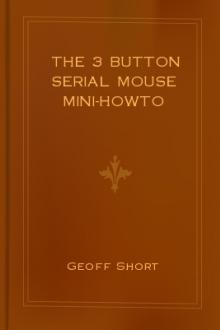The Elements of Drawing by John Ruskin (smart books to read .txt) 📕

- Author: John Ruskin
- Performer: -
Book online «The Elements of Drawing by John Ruskin (smart books to read .txt) 📕». Author John Ruskin
71. Observe, on the other hand, that, however white an object may be, there is always some small point of it whiter than the rest. You must therefore have a slight tone of gray over everything in your picture except on the extreme high lights; even the piece of white paper, in your subject, must be toned slightly down, unless (and there are thousand chances against its being so) it should all be turned so as fully to front the light. By examining the treatment of the white objects in any pictures accessible to you by Paul Veronese or Titian, you will soon understand this.[15]
72. As soon as you feel yourself capable of expressing with the brush the undulations of surfaces and the relations of masses, you may proceed to draw more complicated and beautiful things.[16] And first, the boughs of trees, now not in mere dark relief, but in full rounding. Take the first bit of branch or stump that comes to hand, with a fork in it; cut off the ends of the forking branches, so as to leave the whole only about a foot in length; get a piece of paper the same size, fix your bit of branch in some place where its position will not be altered, and draw it thoroughly, in all its light and shade, full size; striving, above all things, to get an accurate expression of its structure at the fork of the branch. When once you have mastered the tree at its armpits, you will have little more trouble with it.
73. Always draw whatever the background happens to be, exactly as you see it. Wherever you have fastened the bough, you must draw whatever is behind it, ugly or not, else you will never know whether the light and shade are right; they may appear quite wrong to you, only for want of the background. And this general law is to be observed in all your studies: whatever you draw, draw completely and unalteringly, else you never know if what you have done is right, or whether you could have done it rightly had you tried. There is nothing visible out of which you may not get useful practice.
74. Next, to put the leaves on your boughs. Gather a small twig with four or five leaves on it, put it into water, put a sheet of light-colored or white paper behind it, so that all the leaves may be relieved in dark from the white field; then sketch in their dark shape carefully with pencil as you did the complicated boughs, in order to be sure that all their masses and interstices are right in shape before you begin shading, and complete as far as you can with pen and ink, in the manner of Fig. 6, which is a young shoot of lilac.
75. You will probably, in spite of all your pattern drawings, be at first puzzled by leaf foreshortening; especially because the look of retirement or projection depends not so much on the perspective of the leaves themselves as on the double sight of the two eyes. Now there are certain artifices by which good painters can partly conquer this difficulty; as slight exaggerations of force or color in the nearer parts, and of obscurity in the more distant ones; but you must not attempt anything of this kind. When you are first sketching the leaves, shut one of your eyes, fix a point in the background, to bring the point of one of the leaves against; and so sketch the whole bough as you see it in a fixed position, looking with one eye only. Your drawing never can be made to look like the object itself, as you see that object with both eyes,[17] but it can be made perfectly like the object seen with one, and you must be content when you have got a resemblance on these terms.
76. In order to get clearly at the notion of the thing to be done, take a single long leaf, hold it with its point towards you, and as flat as you can, so as to see nothing of it but its thinness, as if you wanted to know how thin it was; outline it so. Then slope it down gradually towards you, and watch it as it lengthens out to its full length, held perpendicularly down before you. Draw it in three or four different positions between these extremes, with its ribs as they appear in each position, and you will soon find out how it must be.
Fig. 6. Fig. 6.77. Draw first only two or three of the leaves; then larger clusters; and practice, in this way, more and more complicated pieces of bough and leafage, till you find you can master the most difficult arrangements, not consisting of more than ten or twelve leaves. You will find as you do this, if you have an opportunity of visiting any gallery of pictures, that you take a much more lively interest than before in the work of the great masters; you will see that very often their best backgrounds are composed of little more than a few sprays of leafage, carefully studied, brought against the distant sky; and that another wreath or two form the chief interest of their foregrounds. If you live in London you may test your progress accurately by the degree of admiration you feel for the leaves of vine round the head of the Bacchus, in Titian's Bacchus and Ariadne. All this, however, will not enable you to draw a mass of foliage. You will find, on looking at any rich piece of vegetation, that it is only one or two of the nearer clusters that you can by any possibility draw in this complete manner. The mass is too vast, and too intricate, to be thus dealt with.
Fig. 7. Fig. 7.78. You must now therefore have recourse to some confused mode of execution, capable of expressing the confusion of Nature. And, first, you must understand what the character of that confusion is. If you look carefully at the outer sprays of any tree at twenty or thirty yards' distance, you will see them defined against the sky in masses, which, at first, look quite definite; but if you examine them, you will see, mingled with the real shapes of leaves, many indistinct lines, which are, some of them, stalks of leaves, and some, leaves seen with the edge turned towards you, and coming into sight in a broken way; for, supposing the real leaf shape to be as at a, Fig. 7, this, when removed some yards from the eye, will appear dark against the sky, as at b; then, when removed some yards farther still, the stalk and point disappear altogether, the middle of the leaf becomes little more than a line; and the result is the condition at c, only with this farther subtlety in the look of it, inexpressible in the wood-cut, that the stalk and point of the leaf, though they have disappeared to the eye, have yet some influence in checking the light at the places where they exist, and cause a slight dimness about the part of the leaf which remains visible, so that its perfect effect could only be rendered by two layers of color, one subduing the sky tone a little, the next drawing the broken portions of the leaf, as at c, and carefully indicating the greater darkness of the spot in the middle, where the under side of the leaf is.
Fig. 8. Fig. 8.This is the perfect theory of the matter. In practice we cannot reach such accuracy; but we shall be able to render the general look of the foliage satisfactorily by the following mode of practice.
79. Gather a spray of any tree, about a foot or eighteen inches long. Fix it firmly by the stem in anything that will support it steadily; put it about eight feet away from you, or ten if you are far-sighted. Put a sheet of not very white paper behind it, as usual. Then draw very carefully, first placing them with pencil, and then filling them up with ink, every leaf-mass and stalk of it in simple black profile, as you see them against the paper: Fig. 8 is a bough of Phillyrea so drawn. Do not be afraid of running the leaves into a black mass when they come together; this exercise is only to teach you what the actual shapes of such masses are when seen against the sky.
80. Make two careful studies of this kind of one bough of every common tree,—oak, ash, elm, birch, beech, etc.; in fact, if you are good, and industrious, you will make one such study carefully at least three times a week, until you have examples of every sort of tree and shrub you can get branches of. You are to make two studies of each bough, for this reason,—all masses of foliage have an upper and under surface, and the side view of them, or profile, shows a wholly different organization of branches from that seen in the view from above. They are generally seen more or less in profile, as you look at the whole tree, and Nature puts her best composition into the profile arrangement. But the view from above or below occurs not unfrequently, also, and it is quite necessary you should draw it if you wish to understand the anatomy of the tree. The difference between the two views is often far greater than you could easily conceive. For instance, in Fig. 9, a is the upper view and b the profile, of a single spray of Phillyrea. Fig. 8 is an intermediate view of a larger bough; seen from beneath, but at some lateral distance also.
81. When you have done a few branches in this manner, take one of the drawings you have made, and put it first a yard away from you, then a yard and a half, then two yards; observe how the thinner stalks and leaves gradually disappear, leaving only a vague and slight darkness where they were; and make another study of the effect at each distance, taking care to draw nothing more than you really see, for in this consists all the difference between what would be merely a miniature drawing of the leaves





Comments (0)